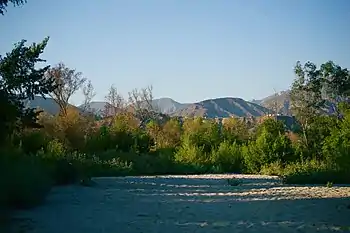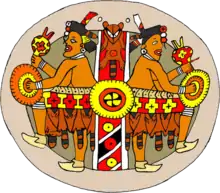Hahamongna, California
Hahamongna and Hahamog-na are historic Tongva-Gabrieleño Native American settlements in the Verdugo Mountains of Southern California, named after the local Tongva band's name Hahamog'na, in present-day Pasadena and Glendale in Los Angeles County, California.[1]

Locations
Hahamog-na - Arroyo Seco
The well studied location named Hahamog-na is the Tongva village archeological site located in the upper Arroyo Seco area just above the Devil's Gate in the present-day Altadena-Pasadena-Jet Propulsion Laboratory-JPL area. It is in the Arroyo Seco canyon-valley and on the lower slopes where the eastern Verdugo Mountains, southern San Gabriel Mountains, and western San Rafael Hills meet. The site of Hahamog-na is now within the protected natural area of Hahamongna Watershed Park, a 300-acre (1.2 km2) habitat and plant community blend of: Freshwater marsh wetlands, riparian zones, native oak woodlands, and chaparral elfin forests.[2][3] This Tongva settlement was later a rancheria on the large 1834 Mexican land grant of Rancho San Pascual, issued by Alta California Governor José Figueroa to Juan Maríne and Eulalia Pérez de Guillén Mariné.[4]
Hahamongna - Glendale
A second settlement site located in present-day Glendale and named Hahamongna existed on the lower southwestern Verdugo Mountains slopes and the eastern San Fernando Valley plain, with the free-flowing Los Angeles River just south. This village location would later be on the western portion of Rancho San Rafael, an early Spanish land grant in 1784 issued by Las Californias Governor Pedro Fages to Spanish Corporal José María Verdugo (1751–1831), in present-day Glendale in the San Fernando Valley.[1]
Hahamog-na Tongva people
The band of Tongva people living in the Verdugo Mountains area, that both settlement locations are within, were named the Hahamog-na and Hahamongna by some Spanish-Mexican eras 'neighbors' and later Euro-American immigrants and historians. The two settlements sharing the 'same sounding' name, with different spellings given by non-native people, may stem from the band inhabiting both places. Research with present-day Tongva-Gabrieleño people, historical researchers and ethnologists, and supported by citations is needed.
See also
- Category: Tongva populated places — all Tongva settlement articles
- Tongva language
- Category: Tongva - all Tongva articles
- Indigenous peoples of California
- Population of Native California
- Rancho La Cañada - adjacent on northeast
- List of Ranchos of California
References
- U.S. Geological Survey Geographic Names Information System: Hahamongna, California
- http://www.lamountains.com/parks.asp?parkid=643 . accessed 8/22/2010
- http://www.savehahamongna.org/ Bounded on the north by the mountains and Jet Propulsion Laboratory and on the south by Devil's Gate Dam, Hahamongna contains five unique habitat zones that only exist in alluvial canyons near the mountains. Most sites like this in Southern California have been destroyed. . accessed 8/28/2010
- Ogden Hoffman, 1862, Reports of Land Cases Determined in the United States District Court for the Northern District of California, Numa Hubert, San Francisco
- Reference citations for the Hahamongna and Tongva entries in the Rancho San Pascual and Eulalia Pérez de Guillén Mariné Wikipedia articles.
External links
- official Hahamongna Watershed Park website
- Hahamongna locator Map
- Save Hahamongna.org website — ongoing open space and historic sites protection, and riparian zone restoration projects.

.svg.png.webp)
